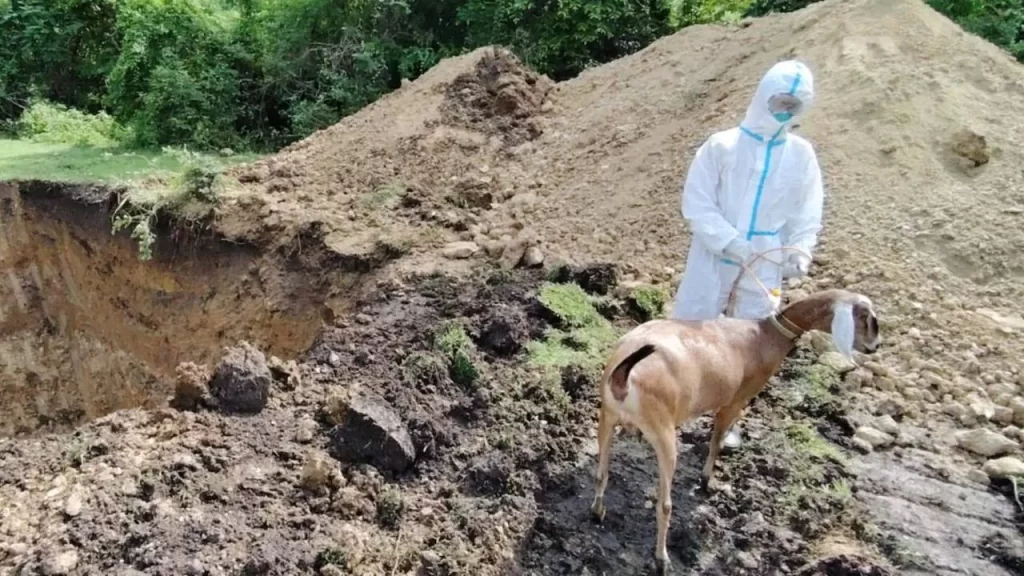Philippines Records First Q Fever Case: Immediate Action Taken 🐐

Coxiella burnetii, the Bacterium Responsible for Q Fever:
A dry fracture of a Vero cell reveals the contents of a vacuole filled with actively growing Coxiella burnetii. NIAID


ADVERTISEMENT
On Friday, June 21, the Bureau of Animal Industry (BAI) under the Department of Agriculture (DA) announced the first case of Q fever in the Philippines.
Q fever, a zoonotic disease caused by the bacterium Coxiella burnetii, which affects goats, sheep, and cows, was identified at a government breeding station in Marinduque. Confirmatory test results were received on Wednesday, June 19.
The BAI reported that they had already culled more than sixty goats imported from the United States, along with other animals at the Marinduque facility.

ADVERTISEMENT
Introduction
In an unprecedented development, the Philippines has reported its first case of Q fever, a zoonotic disease that can affect both humans and animals. The source of this infection has been traced to a batch of goats imported from the United States. Authorities have swiftly responded to this health threat by culling the infected goats to prevent further spread of the disease. This blog post delves into the details of the case, the implications for public health, and the measures being taken to safeguard the population.
The Current Situation
In Santa Cruz, Marinduque, several goats have tested positive for a disease, sparking significant attention and concern. Dr. Christian Daquigan has been actively managing the outbreak and ensuring that it remains contained. Fortunately, the situation is under control, and there are measures in place to prevent further spread.
No Human Cases Yet
One piece of reassuring news is that, as of now, there are no confirmed human cases of the disease in the local area. This is a critical factor in managing the situation and preventing widespread panic. The authorities are closely monitoring the situation to ensure the safety of the public.
Temporary Ban on Goat Importation
To further contain the outbreak, the Department of Agriculture has imposed a temporary ban on the importation of goats from the US. This decisive action is aimed at preventing the introduction of potentially infected animals and safeguarding the health of local livestock.
Understanding Q Fever 🤔
Q fever is caused by the bacterium Coxiella burnetii, which can infect humans, livestock, and other animals. The disease can be transmitted through inhalation of contaminated air, direct contact with infected animals, or consumption of contaminated products. Symptoms in humans range from mild flu-like signs to severe complications like pneumonia or hepatitis.
Key Facts About Q Fever
- Transmission: Airborne, direct contact with animals, or consumption of contaminated products.
- Symptoms: Fever, headache, muscle pain, pneumonia, and hepatitis.
- Prevention: Proper animal handling, quarantine measures, and culling infected livestock.
The First Case in the Philippines 🚨
The detection of Q fever in the Philippines has raised concerns among health officials and the public. This case highlights the importance of stringent animal importation protocols and vigilant health monitoring.
Details of the Case
- Source: Imported goats from the United States.
- Detection: Routine health checks identified the presence of Coxiella burnetii.
- Response: Immediate culling of the infected goats to prevent an outbreak.
Government Response and Measures 🛡️
The Philippine government, in collaboration with health and agricultural agencies, has implemented several measures to address the Q fever threat.
Immediate Actions Taken
- Culling Infected Goats: All goats from the infected batch have been culled to eliminate the source of infection.
- Quarantine Measures: Enhanced quarantine protocols for imported livestock to prevent future cases.
- Public Awareness Campaigns: Educating the public and farmers about Q fever and preventive measures.
Implications for Public Health 🏥
Q fever, while rare, poses significant health risks due to its potential severity and ease of transmission. The swift action taken by the Philippine authorities is crucial in preventing a larger outbreak.
Preventive Measures for Individuals
- Avoid Contact with Infected Animals: Farmers and individuals working with livestock should follow proper hygiene practices.
- Safe Handling of Animal Products: Ensure thorough cooking and processing of animal products.
- Seek Medical Attention: If symptoms appear, seek immediate medical advice.
Impact on Local Farmers
The outbreak has significantly impacted local farmers in Santa Cruz, Marinduque. Many are worried about the health of their livestock and the economic repercussions of the disease. The temporary ban on goat importation has also affected their operations, highlighting the need for effective disease management strategies.
Impact on Local Farmers
The outbreak has significantly impacted local farmers in Santa Cruz, Marinduque. Many are worried about the health of their livestock and the economic repercussions of the disease. The temporary ban on goat importation has also affected their operations, highlighting the need for effective disease management strategies.

ADVERTISEMENT
FAQs About Q Fever in the Philippines ❓
What is Q fever?
Q fever is a zoonotic disease caused by the bacterium Coxiella burnetii, affecting both humans and animals.
How did Q fever reach the Philippines?
The first case was detected in goats imported from the United States.
What measures are being taken to prevent further spread?
The government has culled the infected goats, enhanced quarantine protocols, and launched public awareness campaigns.
What are the symptoms of Q fever in humans?
Symptoms include fever, headache, muscle pain, pneumonia, and hepatitis.
How can individuals protect themselves from Q fever?
Avoid contact with infected animals, handle animal products safely, and seek medical advice if symptoms appear.
Conclusion 🎯
The first case of Q fever in the Philippines serves as a critical reminder of the importance of vigilant health monitoring and swift response to zoonotic diseases. The decisive actions taken by the authorities demonstrate their commitment to protecting public health and preventing further outbreaks. As the situation evolves, continued public awareness and adherence to preventive measures will be key in managing and mitigating the impact of Q fever.
Call to Action
Stay informed and take proactive steps to protect yourself and your community from zoonotic diseases. Follow the latest updates and guidelines from health authorities to stay safe.
Related Searches:
- What is Q fever in the Philippines?
- Is there Q fever in Asia?
- Where is Q fever most common?
- What is Q fever vaccine for?

Deia Dee is an experienced Content Writer and SEO Specialist with a passion for Online Gaming, Entertainment, News industry. With 4 years of expertise in creating engaging, informative, and SEO-optimized content, Deia Dee has become a trusted voice in the gaming community. She excels in breaking down complex topics into easy-to-understand guides that help readers make the most of their online gaming experiences.
Deia’s work is characterized by a keen attention to detail and a deep understanding of what online gamers are looking for. Her articles are not only informative but also engaging, making them a valuable resource for both new and seasoned gamers. Deia’s dedication to providing high-quality content ensures that readers can trust her guides to be accurate, helpful, and up-to-date.
In her free time, Deia enjoys exploring news online games, staying updated with the latest gaming trends, and sharing her insights with a broader audience. Through her writing, she aims to enhance the news, entertainment, online gaming experience for readers and players around the world.



